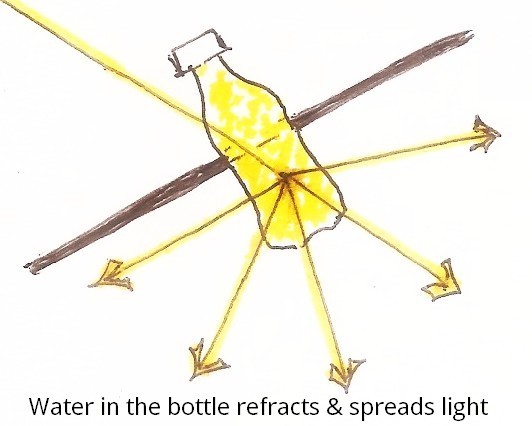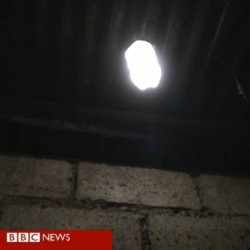 Sometimes, a simple idea can be immensely powerful. Maybe the bottle light is not something that makes a huge difference to your life or mine but, for those who live in shanties with little or no electricity, this is a godsend.
Sometimes, a simple idea can be immensely powerful. Maybe the bottle light is not something that makes a huge difference to your life or mine but, for those who live in shanties with little or no electricity, this is a godsend.
 Essentially, one fills a used, transparent, plastic bottle with water and a little bleach (to prevent algae) and sticks it into a hole in the roof. That’s it. Oh, and don’t forget to seal the edges of the hole.
Essentially, one fills a used, transparent, plastic bottle with water and a little bleach (to prevent algae) and sticks it into a hole in the roof. That’s it. Oh, and don’t forget to seal the edges of the hole.
The light that it produces is equivalent to a 50 or 60W bulb. Of course it won’t work at night but when you think of the dark homes that some of our less fortunate citizens live in, this can—at the very least—brighten up their day.
More:
BBC News Magazine
Instructables
A Liter of Light
Passive Solar Hot Water

Solar hot-water panels at the PMK Bungalow
One of the cheapest and most effective ways to use solar energy is for heating water — replacing electric geysers with solar heaters can reduce your bills quite dramatically. These panels are quite different from the solar photo-voltaic (PV) panels which produce electricity in that they contain no electronic parts and are fairly easy to maintain.
There are two types of panels and their usage depends on budget and climatic factors.
In most tropical climates, the ordinary collectors work well. These collectors consist of copper fins that heat up rapidly and transfer this heat to copper pipes attached directly behind them. The pipes supply hot water to a storage tank by thermo-siphon and the whole assembly is put behind a glass pane for protection.
The other type of panel becomes necessary in places with extreme climates. Called Evacuated Vacuum Tube Collectors these are much more efficient but also more expensive. Here an outer tube of borosilicate glass has an absorptive layer and an inner tube to which the heat is transferred. Here too, the water rises by convection into a storage tank.
Tips
You will definitely need to have an insulated collection tank to store the hot water generated, especially if you want to use it before the sun comes up the next morning. Also make sure that the piping from the panel to the tank is properly insulated – this is something the installers often “forget”.
There are times of the year when heating won’t be very effective – due to cloud cover, for instance. For the monsoon and for early winter mornings, it might be useful to pipe the water though instant-type heaters in individual bathrooms to boost the temperature.
External Links
More
If you are the manufacturer/dealer of any product that you feel is appropriate for this page, please fill this form stating clearly what exactly makes your product green/sustainable.
Please note that Greenwashing will not get you anywhere and inclusion of the product is not guaranteed and is entirely at our discretion.
This is the ideal air conditioner – the hotter the sun gets the better the a/c works. Still, there have been drawbacks that made such machines non-viable. Now, a company called GreenCore Air has released a hybrid unit that claims to have solved the inefficiency problem.
Go to :: GreenCore The website has been squatted upon. Try this company instead.
via :: MetaEfficient
The Clinton Foundation is talking to the Gujarat Government to set up a “solar city” project that will eventually generate 5 gigawatts of power. Talks are also on with the Andhra Pradesh and Rajasthan for setting up solar energy projects.
Now we can only hope that the Great Indian Bureaucracy doesn’t kill this initiative…
Full Article :: Business Standard via :: TreeHugger
 Sometimes, a simple idea can be immensely powerful. Maybe the bottle light is not something that makes a huge difference to your life or mine but, for those who live in shanties with little or no electricity, this is a godsend.
Sometimes, a simple idea can be immensely powerful. Maybe the bottle light is not something that makes a huge difference to your life or mine but, for those who live in shanties with little or no electricity, this is a godsend. Essentially, one fills a used, transparent, plastic bottle with water and a little bleach (to prevent algae) and sticks it into a hole in the roof. That’s it. Oh, and don’t forget to seal the edges of the hole.
Essentially, one fills a used, transparent, plastic bottle with water and a little bleach (to prevent algae) and sticks it into a hole in the roof. That’s it. Oh, and don’t forget to seal the edges of the hole.

